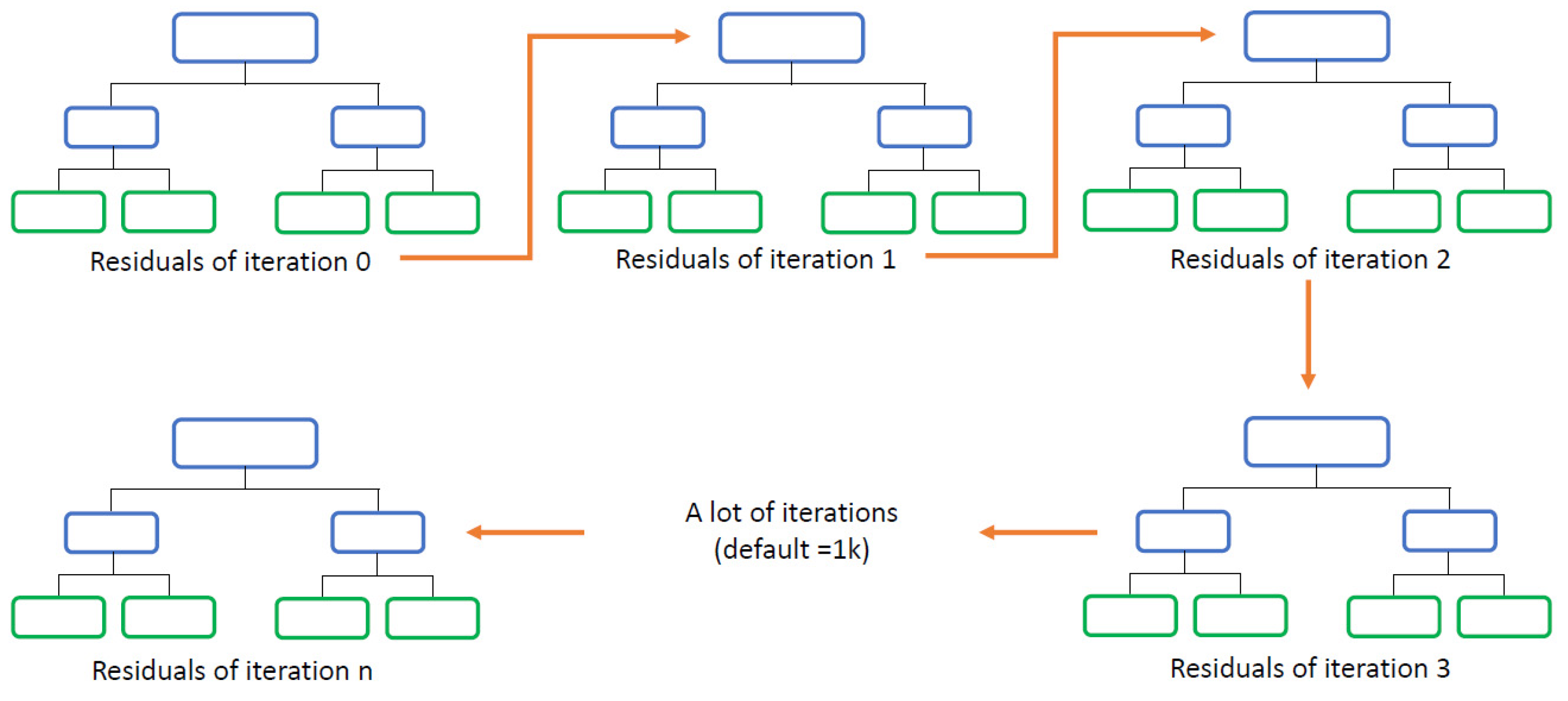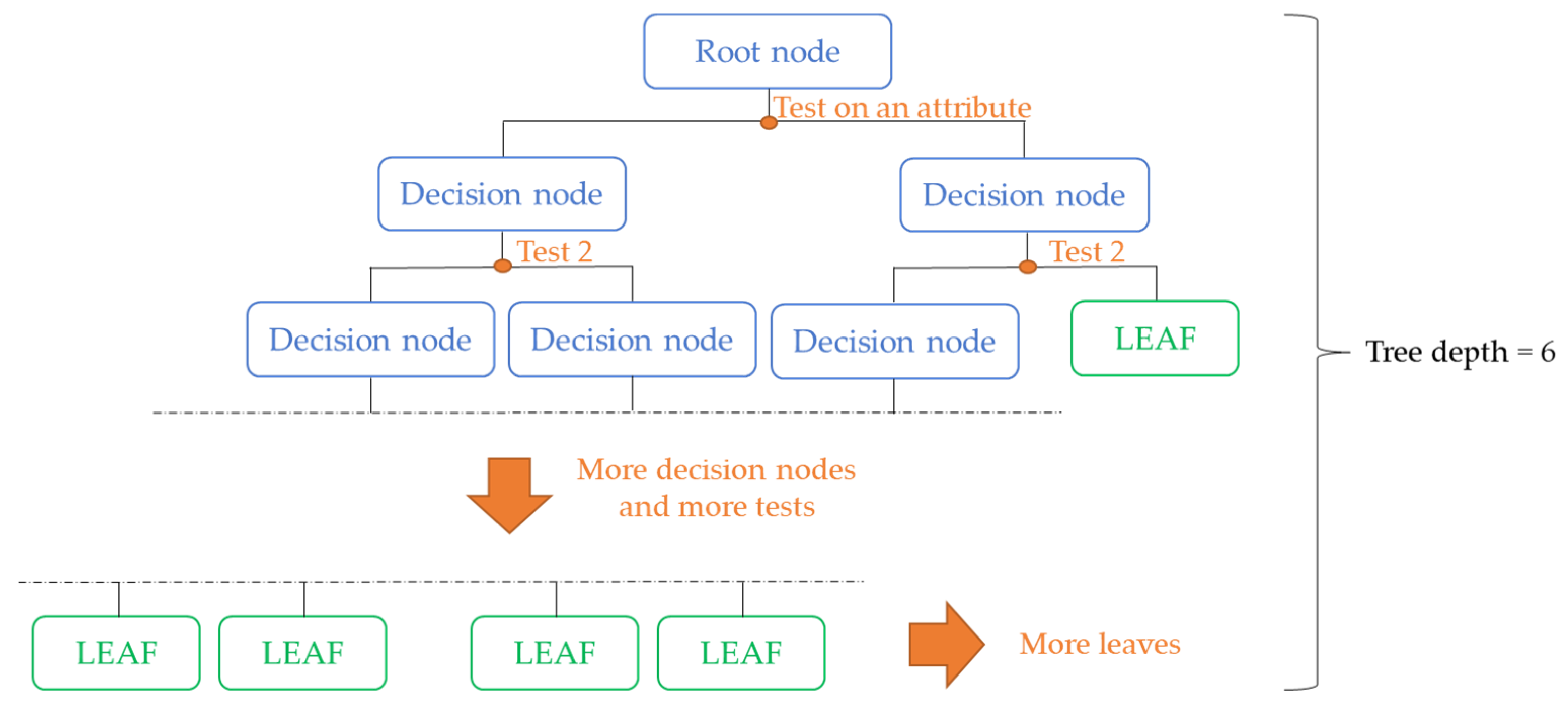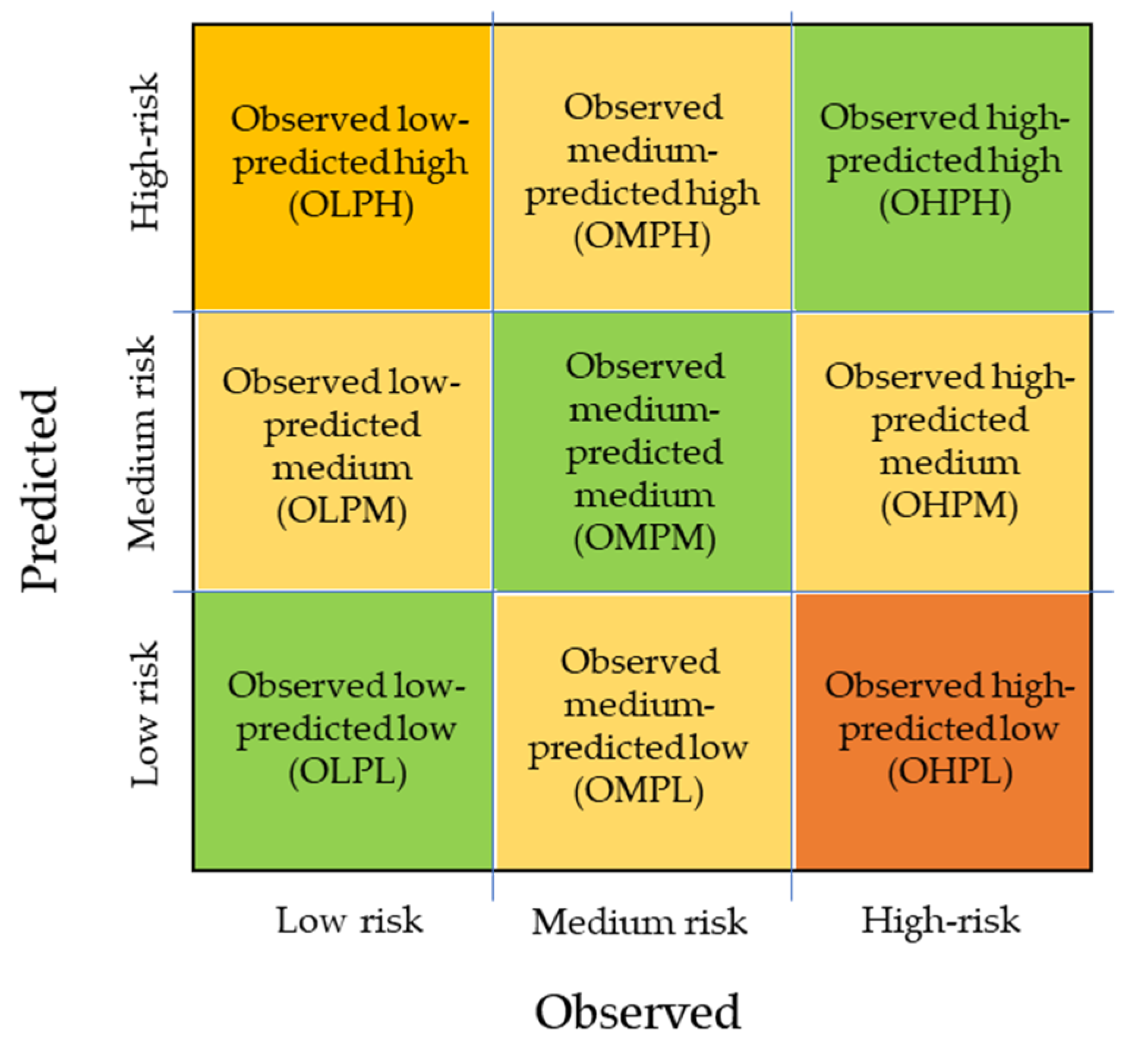A Predictive Pedestrian Crash Model Based on Artificial Intelligence Techniques
Abstract
:1. Introduction
2. Data and Methods
2.1. Data
2.1.1. Data Overview
2.1.2. Data Manipulation
- Full address (e.g., street name and number of intersections);
- Incomplete address (e.g., street name without street number);
- Proximity to a point of interest (e.g., in front of a shop/church/school/cinema/supermarket, etc.);
- Proximity to a traffic light or light pole (e.g., distance from a traffic light/light pole #);
- No information about the location.
- Section type (intersection or not);
- Presence of a traffic light (yes or no);
- Presence of a road bump (yes or no);
- Presence of a pedestrian crossing (yes or no);
- Presence of parking lots (yes or no);
- If the road is a one-way road (yes or no);
- Total number of lanes;
- Proximity to a bus stop (yes or no).
- The count of accidents per road section might not be the total number of accidents that occurred in the location analyzed due to the presence of poor address descriptions in the ISAT database. Consequently, more than 60% of the addresses related to pedestrian accidents could not be accurately localized;
- The characterization of the road stretches was performed in December 2020 and cannot consider any previous configuration. For example, bus stops could have been in different locations in the period of data collection.
2.2. Methodology
2.2.1. The CatBoost Algorithm
2.2.2. Variables Used
- 60 observations of low risk (fewer than 5 accidents with no more than one fatal accident with pedestrians involved between 2014 and 2018);
- 95 observations of medium risk (between 5 and 9 accidents with no more than two fatal accidents with pedestrians involved between 2014 and 2018);
- 25 observations of high risk (more than 10 accidents without limitation for fatal accidents with pedestrians involved between 2014 and 2018).
3. Results and Discussion
4. Conclusions
Author Contributions
Funding
Institutional Review Board Statement
Informed Consent Statement
Data Availability Statement
Conflicts of Interest
References
- WHO—World Health Organization. Global Status Report on Road Safety; World Health Organization: Geneva, Switzerland, 2018. [Google Scholar]
- Khan, M.A.B.; Grivna, M.; Nauman, J.; Soteriades, E.S.; Cevik, A.A.; Hashim, M.J.; Govender, R.; Al Azeezi, S.R. Global Incidence and Mortality Patterns of Pedestrian Road Traffic Injuries by Sociodemographic Index, with Forecasting: Findings from the Global Burden of Diseases, Injuries, and Risk Factors 2017 Study. Int. J. Environ. Res. Public Health 2020, 17, 2135. [Google Scholar] [CrossRef] [Green Version]
- European Commission. Facts and figures pedestrians. In European Road Safety Observatory; Directorate General for Transport, European Commission: Brussels, Belgium, 2020. [Google Scholar]
- ACI-ISTAT. Incidenti stradali in Italia. In Report of ACI-ISTAT—Anno 2019; ACI: Roma, Italy, 2020. (In Italian) [Google Scholar]
- WHO—World Health Organization. Global Status Report on Road Safety: Supporting a Decade of Action; World Health Organization: Geneva, Switzerland, 2013. [Google Scholar]
- Kraidi, R.; Evdorides, H. Pedestrian safety models for urban environments with high roadside activities. Saf. Sci. 2020, 130, 104847. [Google Scholar] [CrossRef]
- Yannis, G.; Dragomanovits, A.; Laiou, A.; Richter, T.; Ruhl, S.; La Torre, F.; Domenichini, L.; Graham, D.; Karathodorou, N.; Li, H. Use of Accident Prediction Models in Road Safety Management—An International Inquiry. Transp. Res. Procedia 2016, 14, 4257–4266. [Google Scholar] [CrossRef] [Green Version]
- La Torre, F.; Domenichini, L.; Meocci, M.; Graham, D.; Karathodorou, N.; Richter, T.; Ruhl, S.; Yannis, G.; Dragomanovits, A.; Laiou, A. Development of a transnational accident prediction model. Transp. Res. Procedia 2016, 14, 1772–1781. [Google Scholar] [CrossRef] [Green Version]
- Srinivasan, R.; Bauer, K. Safety Performance Function Development Guide: Developing Jurisdiction-Specific SPFs, Final Report; Report No. FSWA-SA-14-005; Federal Highway Administration: Washington, DC, USA, 2013.
- AASHTO. Highway Safety Manual, 1st ed.; American Association of State and Highway Transportation Officials: Washington, DC, USA, 2010. [Google Scholar]
- Chakraborty, A.; Mukherjee, D.; Mitra, S. Development of pedestrian crash prediction model for a developing country using artificial neural network. Int. J. Inj. Control Saf. Promot. 2019, 26, 283–293. [Google Scholar] [CrossRef]
- Brüde, U.; Larsson, J. Models for predicting accidents at junctions where pedestrians and cyclists are involved. How well do they fit? Accid. Anal. Prev. 1993, 25, 499–509. [Google Scholar] [CrossRef] [Green Version]
- Lee, C.; Abdel-Aty, M. Comprehensive analysis of vehicle-pedestrian crashes at intersections in Florida. Accid. Anal. Prev. 2005, 37, 775–786. [Google Scholar] [CrossRef]
- Rankavat, S.; Tiwari, G. Association between Built Environment and Pedestrian Fatal Crash Risk in Delhi, India. Transp. Res. Rec. 2015, 2519, 61–66. [Google Scholar] [CrossRef] [Green Version]
- Eluru, N.; Bhat, C.R.; Hensher, D.A. A mixed generalized ordered response model for examining pedestrian and bicyclist injury severity level in traffic crashes. Accid. Anal. Prev. 2008, 40, 1033–1054. [Google Scholar] [CrossRef] [Green Version]
- Ewing, R.; Dumbaugh, E. The Built Environment and Traffic Safety: A Review of Empirical Evidence. J. Plan. Lit. 2009, 23, 347–367. [Google Scholar] [CrossRef]
- Feng, C. Synthesis of Studies on Speed and Safety. Transp. Res. Rec. 2001, 1779, 86–92. [Google Scholar] [CrossRef]
- Gårder, P.E. The impact of speed and other variables on pedestrian safety in Maine. Accid. Anal. Prev. 2004, 36, 533–542. [Google Scholar] [CrossRef]
- Olszewski, P.; Osinska, B.; Szagała, P.; Włodarek, P. Development of accident prediction models for pedestrian crossings. MATEC Web Conf. 2018, 231, 3002. [Google Scholar] [CrossRef]
- Lu, P.; Zheng, Z.; Ren, Y.; Zhou, X.; Keramati, A.; Tolliver, D.; Huang, Y. A Gradient Boosting Crash Prediction Approach for Highway-Rail Grade Crossing Crash Analysis. J. Adv. Transp. 2020, 2020, 6751728. [Google Scholar] [CrossRef]
- Mohamedshah, Y.M.; Paniati, J.F.; Hobeika, A.G. Truck accident models for interstates and two-lane rural roads. Transp. Res. Rec. J. Transp. Res. Board 1993, 1407, 35–41. [Google Scholar]
- Yan, X.; Radwan, E. Analyses of rear-end crashes based on classification tree models. Traffic Inj. Prev. 2006, 7, 276–282. [Google Scholar] [CrossRef]
- Qin, X.; Han, J. Variable selection issues in tree-based regression models. Transp. Res. Rec. J. Transp. Res. Board 2008, 2061, 30–38. [Google Scholar] [CrossRef] [Green Version]
- American Association of State Highway and Transportation Officials (AASHTO). Highway Safety Manual Supplement; Chapter 18; American Association of State Highway and Transportation Officials: Washington, DC, USA, 2014. [Google Scholar]
- Hauer, E. Speed and safety. Transp. Res. Rec. J. Transp. Res. Board 2009, 2103, 10–17. [Google Scholar] [CrossRef] [Green Version]
- Domenichini, L.; Branzi, V.; Meocci, M. Virtual testing of speed reduction schemes on urban collector roads. Accid. Anal. Prev. 2018, 110, 38–51. [Google Scholar] [CrossRef]
- Branzi, V.; Meocci, M.; Domenichini, L.; La Torre, F. Drivers’ performance in response to engineering treatments at pedestrian crossings. Adv. Transp. Stud. Int. J. 2018, 1, 55–70. [Google Scholar]
- Leaf, W.A.; Preusser, D.F. Literature Review on Vehicle Travel Speeds and Pedestrian Injuries; National Highway Traffic Safety Administration: Washinghtond, DC, USA, 1999.
- Tefft, B.C. Impact Speed and a Pedestrian’s Risk of Severe Injury or Death; AAA Foundation for Traffic Safatey: Washington, DC, USA, 2011. [Google Scholar]
- Ronsen, E.; Stigson, H.; Sander, U. Literature review of pedestrian fatality risk as a function of car impact speed. Accid. Anal. Prev. 2011, 43, 25–33. [Google Scholar] [CrossRef] [PubMed]
- Kroyer, H.R.G. Is 30 km/h a “safe” speed? Injury severity of pedestrian struck by a vehicle and the relation to travel speed and age. IATSS Res. 2015, 39, 42–50. [Google Scholar] [CrossRef] [Green Version]
- ISTAT. File di Microdati per la Ricerca—MFR, 2014–2018; Istat—Istituto Nazionale di Statistica: Roma, Italy, 2020. [Google Scholar]
- Google Cloud APIs. Available online: https://cloud.google.com/apis (accessed on 9 September 2021).
- Shapire, R.E. The strength of weak learnability. Mach. Learn. 1990, 5, 197–227. [Google Scholar] [CrossRef] [Green Version]
- Natekin, A.; Knoll, A. Gradient boosting machines, a tutorial. Front. Neurorobot. 2013, 7, 21. [Google Scholar] [CrossRef] [Green Version]
- Yandex, catBoost Fit. Available online: https://catboost.ai/docs/concepts/python-reference_catboostclassifier_fit.html (accessed on 8 October 2021).
- Prokhorenkova, L.; Gusev, G.; Vorobev, A.; Dorogush, A.V.; Gulin, A. Catboost: Unbiased boosting with categorical features. In Advances in Neural Information Processing Systems; Bengio, S., Wallach, H., Larochelle, H., Grauman, K., Cesa-Bianchi, N., Garnett, R., Eds.; Curran Associates Inc.: Montreal, QC, Canada, 2018; Volume 31, pp. 6638–6648. [Google Scholar]
- Hancock, J.T.; Khoshgoftaar, T.M. CatBoost for big data: An interdisciplinary review. J. Big Data 2020, 7, 94. [Google Scholar] [CrossRef]
- Bentejac, C.; Csorgo, A.; Martinez-Munoz, G. A comparative analysis of gradient boosting algorithms. Artif. Intell. Rev. 2021, 54, 1937–1967. [Google Scholar] [CrossRef]
- Consiglio Nazionale delle Ricerche, CNR. Criteri per la Classificazione Della Rete Delle Strade Esistenti ai Sensi Dell’art. 13, Comma 4 e 5 del Nuovo Codice Della Strada; CNR: Roma, Italy, 1998. (In Italian)
- Abojaradeh, M. Evaluation of Pedestrian Bridges and Pedestrian Safety in Jordan. Civ. Environ. Res. 2003, 3, 66–78. [Google Scholar]
- Karlaftis, M.G.; Golias, I. Effects of road geometry and traffic volumes on rural roadway accident rates. Accid. Anal. Prev. 2002, 34, 357–365. [Google Scholar] [CrossRef]
- Santhosh, A.; Sam, E.; Bindhu, B.K. Pedestrian Accident Prediction Modelling—A Case Study in Thiruvananthapuram City. In Transportation Research. Lecture Notes in Civil Engineering; Mathew, T., Joshi, G., Velaga, N., Arkatkar, S., Eds.; Springer: Singapore, 2020; Volume 45. [Google Scholar] [CrossRef]
- Ulak, M.B.; Kocatepe, A.; Yazici, A.; Ozguven, E.E.; Kumar, A. A stop safety index to address pedestrian safety around bus stops. Saf. Sci. 2021, 133, 105017. [Google Scholar] [CrossRef]
- Kapousizis, G.; Goodman, A.; Aldred, R. Cycling injury risk in Britain: A case-crossover study of infrastructural and route environment correlates. Accid. Anal. Prev. 2021, 154, 106063. [Google Scholar] [CrossRef]






| Vehicle | Pedestrian | Numbers of Accidents |
|---|---|---|
| No priority to the pedestrian on the appropriate crossings. | Crossed at a pedestrian crossing not protected by traffic lights or traffic warden. | 13,970 |
| Legitimate behavior. | Illicit street crossing. | 12,332 |
| No priority to the pedestrian on the appropriate crossings. | Crossing at a pedestrian crossing respecting the signs. | 6214 |
| Legitimate behavior. | Walked in the middle of the road. | 3865 |
| Legitimate behavior. | Came out from behind a parked or stopped vehicle. | 2974 |
| Information | Most Frequently Occurring Data |
|---|---|
| driving environment | urban |
| gender of drivers | male |
| age of drivers | 36–55 |
| gender of pedestrian | male |
| age of pedestrian killed | >65 years |
| road section | straightaways/crossings |
| road surface | paved |
| road surface condition | dry |
| traffic condition | peak hours |
| week period | working day |
| Variables | Role | Type |
|---|---|---|
| Number of lines | Independent variable | Numerical—discrete |
| Morning traffic | Independent variable | Numerical—continuous |
| Afternoon traffic | Independent variable | Numerical—continuous |
| Evening traffic | Independent variable | Numerical—continuous |
| Night traffic | Independent variable | Numerical—continuous |
| Section type | Independent variable | Categorical |
| Presence of bus stop | Independent variable | Categorical |
| Presence of parking lots | Independent variable | Categorical |
| One way street | Independent variable | Categorical |
| Presence of pedestrian crossing | Independent variable | Categorical |
| Presence of road bump | Independent variable | Categorical |
| Presence of traffic light | Independent variable | Categorical |
| Level of risk | Dependent (Output) variable | Categorical |
| Results of the 5-Fold Iterations | ||||||
|---|---|---|---|---|---|---|
| Measures | Class | Value | Value | Value | Value | Value |
| Recall | Low risk | 1.000 | 0.733 | 0.800 | 0.875 | 1 |
| Recall | Medium risk | 0.737 | 0.938 | 0.900 | 0.647 | 0.550 |
| Recall | High-risk | 0.556 | 0.500 | 0.800 | 0.800 | 0.875 |
| Precision | Low risk | 0.679 | 0.925 | 0.815 | 0.711 | 0.679 |
| Precision | Medium risk | 0.581 | 0.451 | 0.700 | 0.590 | 0.703 |
| Precision | High-risk | 1.000 | 1.000 | 1.000 | 0.964 | 0.9193 |
| Accuracy | - | 0.650 | 0.676 | 0.707 | 0.749 | 0.703 |
| Measures | Class | Average | Minimum | Maximum | Standard Deviation |
|---|---|---|---|---|---|
| Recall | Low risk | 0.88 | 0.73 | 1.00 | 0.12 |
| Recall | Medium risk | 0.75 | 0.55 | 0.94 | 0.16 |
| Recall | High-risk | 0.71 | 0.50 | 0.88 | 0.17 |
| Precision | Low risk | 0.76 | 0.68 | 0.92 | 0.11 |
| Precision | Medium risk | 0.61 | 0.45 | 0.70 | 0.10 |
| Precision | High-risk | 0.98 | 0.92 | 1.00 | 0.04 |
| Accuracy | - | 0.70 | 0.65 | 0.75 | 0.04 |
Publisher’s Note: MDPI stays neutral with regard to jurisdictional claims in published maps and institutional affiliations. |
© 2021 by the authors. Licensee MDPI, Basel, Switzerland. This article is an open access article distributed under the terms and conditions of the Creative Commons Attribution (CC BY) license (https://creativecommons.org/licenses/by/4.0/).
Share and Cite
Meocci, M.; Branzi, V.; Martini, G.; Arrighi, R.; Petrizzo, I. A Predictive Pedestrian Crash Model Based on Artificial Intelligence Techniques. Appl. Sci. 2021, 11, 11364. https://doi.org/10.3390/app112311364
Meocci M, Branzi V, Martini G, Arrighi R, Petrizzo I. A Predictive Pedestrian Crash Model Based on Artificial Intelligence Techniques. Applied Sciences. 2021; 11(23):11364. https://doi.org/10.3390/app112311364
Chicago/Turabian StyleMeocci, Monica, Valentina Branzi, Giulia Martini, Roberto Arrighi, and Irene Petrizzo. 2021. "A Predictive Pedestrian Crash Model Based on Artificial Intelligence Techniques" Applied Sciences 11, no. 23: 11364. https://doi.org/10.3390/app112311364
APA StyleMeocci, M., Branzi, V., Martini, G., Arrighi, R., & Petrizzo, I. (2021). A Predictive Pedestrian Crash Model Based on Artificial Intelligence Techniques. Applied Sciences, 11(23), 11364. https://doi.org/10.3390/app112311364







